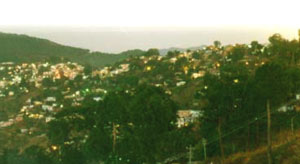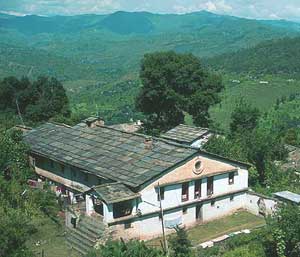| Destinations
|
|||
 Almora is perched on a five-kilometre long horseshoe-shaped ridge, 1,650 metres above sea level. The town looks out over a fertile terraced valley and four ranges of hills - Banari Devi, Kasan Devi, Shyahi Devi and Katarmal. From the town one can see the magnificent Himalyan ranges to the North with the peaks of Trishul, Nanda Devi and Nanda Kot rising tall in majestic splendour. Almora is perched on a five-kilometre long horseshoe-shaped ridge, 1,650 metres above sea level. The town looks out over a fertile terraced valley and four ranges of hills - Banari Devi, Kasan Devi, Shyahi Devi and Katarmal. From the town one can see the magnificent Himalyan ranges to the North with the peaks of Trishul, Nanda Devi and Nanda Kot rising tall in majestic splendour.
Many hill stations, like Nainital for example, were established by the British. But Almora is a magnificent town with a long history. The Kashaya Hill on which the town is built finds a mention in the scripture of the Skanda Purana. In 1560 Raja Kalyan Chand of Kumaon made it the capital of his kingdom. At that time it was called Rajapur and ancient inscriptions on many places still have Rajapur carved on them The rule of Chand dynasty came to an end after the gorkhas from Nepal occupied the area in 1790. The British defeated the Gorkhas in 1815, and established a small Army establishment and a Cantonment. Swami Vivekanada had this to say about Almora. "These mountains are associated with the best memories of our race: Here, therefore, must be one of centres, not merely of activity, but more of calmness of meditation, and of peace and I hope some one day to realize it." In fact he expressed a desire to have a meditation centre established here and the Ramakrishna Mission at Bright End Corner is a not an active ashram but is a quiet retreat for monks. Just below the town, on either side, flow the Koshi (Kaushaki) and Suyal (Salmali) rivers. |
More on Uttarakhand • Overview • Uttarakhand Districts • Char Dham Yatra • Corbett National Park • Nainital • Valley of Flowers • Mussoorie • Badrinath • Haridwar • Rishikesh • Festivals of Kumaon
Travelogues
WildLife
Pilgrimages
Trekking |
||
Local sights The charm of Almora does not lie in the overcrowded Mall. It lies in other places that include: The Almora Bazaar. The cobbled stone streets of the bazaar are a delight to walk through. Houses and shops align the narrow streets that bustle with activity in the evenings. The traditional architecture is very much in evidence here as one spots carved doors and windows. Some of the best examples of the old styles of architecture van be found in Khazanchi Mohalla, an area which once belonged to the state treasurers. As you walk on the cobbles stoned path the markets change from Lala Bazar at one end to Thana Bazar on the other. In between are Karkhana Bazar, Khajanchi Mohalla, Jauhari Mohalla, Malli Bazar and Tamta Mohalla. Tamta Mohalla just short of the Cantonment. One of the traditional crafts of Almora is copperware and some of the best coppersmiths still work from their traditional area Tamta Mohalla. As you walk through this area the air reverberates with the sound of wooden hammers on metal and one can spot the Tamta community at work carving exquisite brass utensils and decorative items. Nanda Devi Temple: This temple is dedicated to the patron goddess of the local population and the Chand rajas, and is located in the antechamber of a Shiva temple in the Bazaar above the Mall. Collectorate: The highest point on the city side, above the Mall, is the Collectorate. This is in fact the old Almora fort, from where you can get a wonderful view of Almora and the surrounding mountains. The district Collectors office and the court are located here.
Simtola: 3 kms from Almora, on the opposite side of the horseshoe ridge, is the pine-covered picnic spot. Close by are Hiradungi, once a diamond mining centre and the scenic Greynite Hill. Kalimath: Excellent views of Almora and the Himalayan peaks can be had from Kalimath four 4.5 kms from Almora. Kasar Devi temple: Six kilometres from Almora, Kasar Devi temple is a serene spot to visit. Swami Vivekananda came to this spot to meditate and the place certainly has an atmosphere. Cranks Ridge: A recommended spot for spending long hours is Crank's Ridge. Located just short of Kasar Devi, the place has been a favoured haunt of artists and writers. D H Lawrence spent two summers here, and it has also attracted Bob Dylan, Cat Stevens and Timothy Leary, the father of the hippy movement. Tara's Tea Shop at the ridge caters to a small community of back packers and ex hippies that seem to have settled here since the place happened to get the reputation of being a ' power centre' during the hippie hey days. His serving of Somosa and Chole is a delight with hot tea. Upreti Khola: 2 kms from the Kasar Devi temple, in Upreti Khola , is a second-century-BC rock inscription dedicated to the goddess. Chitai: The famous hilltop temple of Chitai is 6 kms from Almora. Lord Golla, to whom the temple is dedicated is a deified general of the Chand dynasty. The shrine and the trees in the compound are decorated with bells offered by devotees who tie a bell either while making a wish or in thanksgiving. Getting there: The nearest railhead is Kathgodam, 90 kilometres or 3 hours from Almora via Khairna. The approach road to Almora bypasses the route to Nainital on the left. Almora is 335 kilometres from Delhi and 196 kilometres from Bareilly by road. Around Almora: Jageshwar : 34 kms from Almora is the ancient Shiva temple complex at Jageshwar. The main Shiva temple here houses one of the 12 jyotirlingas in the country. The temple complex is located in the middle of a dense deodar forest. There are 12 temples in the complex dating back to the 7th century. Katarmal: There are very few temples dedicated to the Sun God. The most famous sun Temple in the country is of course Konark, in Orissa, The lesser known Sun temple at Katarmal is almost 800 years old but badly neglected. Katarmal is 17 kms from Almora. Binsar : Binsar is located in the midst of dense forests 30 kms from Almora. It derives its name from Binsar Deo or Shiva. The Shiva temple here was built by the Chandravanshi King Kalyan.
Compiled by Rajiv Butalia
|
|||
Editor: Romola Butalia (c) India Travelogue. All rights reserved. |
|||
 The main thoroughfare is the Mall where the bus stand is established. Approx 1.5 kms before the bus stand is the Kumaon Mandal Holiday Home which offers rooms at reasonable prices. The quality of service is passable but the place makes up by offering great views and calm open picturesque surroundings. The area around the bus stand is dotted with numerous small shops selling local sweets including the famous 'bal mithai' that tastes like fudge.
The main thoroughfare is the Mall where the bus stand is established. Approx 1.5 kms before the bus stand is the Kumaon Mandal Holiday Home which offers rooms at reasonable prices. The quality of service is passable but the place makes up by offering great views and calm open picturesque surroundings. The area around the bus stand is dotted with numerous small shops selling local sweets including the famous 'bal mithai' that tastes like fudge.

 Bright End Corner: Some say this picturesque corner, located 2 kms from the centre of the city on the approach road was named after Brighton in England and that it is actually Brighton End Corner. But I prefer to think that it is called Bright End Corner because it is at one end of the Almora ridge and offers some of the most spectacular sunsets you will ever get to see in the hills.
Bright End Corner: Some say this picturesque corner, located 2 kms from the centre of the city on the approach road was named after Brighton in England and that it is actually Brighton End Corner. But I prefer to think that it is called Bright End Corner because it is at one end of the Almora ridge and offers some of the most spectacular sunsets you will ever get to see in the hills.